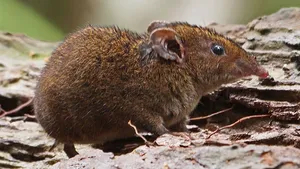If you cannot find the answer you are looking for, please contact us.
Mindanao gymnure

First described in 1905, the Mindanao Gymnure is a medium-sized forest mammal endemic to Mindanao, distinguished by its dense soft fur, long whiskers, and pungent scent used for defense.
Taxonomy
| Kingdom: | Animalia |
| Phylum: | Chordata |
| Class: | Mammalia |
| Order: | Eulipotyphla |
| Family: | Erinaceidae |
| Genus: | Podogymnura |
| Species: | Podogymnura truei |
Not a ‘real’ hedgehog
Although part of the hedgehog family, the Mindanao Gymnure belongs to the subfamily gymnures, also known as hairy hedgehogs, not the spiny, curled-up hedgehogs. Like its relatives, it is nocturnal, insectivorous, and has a strong sense of smell. Yet it lacks quills, cannot roll into a defensive ball, and instead resembles a shrew, with a slender body, long snout, and soft fur, highlighting its unique evolutionary path.
Natural range & habitat
This species is endemic to the mountainous regions of Mindanao in the Philippines, specifically in the provinces of Bukidnon, Davao del Norte, and Davao del Sur. It inhabits moist montane and mossy forests, typically between 1,300 and 2,900 meters elevation, and is particularly abundant in the cloud forest zones around Mount Apo, Mount Kitanglad, and Mount Kalatungan. It shelters among tangled tree roots, moss-covered logs, streamside ferns, and dense undergrowth, often in proximity to standing water or damp ground.
Physical traits
A medium-sized gymnure, this animal measures approximately 13 to 15 cm in body length, with a well-furred tail around 4 to 7 cm long, about one-third of its body length. Weight ranges between 40 and 80 g. Its dorsal fur is long, soft, and grey interspersed with reddish-brown hairs; its belly is hoary with brown and white tones. It has a long, sensitive snout, large semi-naked ears, robust whiskers, and a strong tail. An anal gland releases a strong garlic- or onion-like odor when threatened.
Behavior & lifestyle
This gymnure is strictly terrestrial and nocturnal or crepuscular. It remains hidden during the day in burrows or dense forest cover, emerging at night to forage. It actively moves through undergrowth and fallen debris, creating narrow runways beneath moss and ferns. It is solitary and territorial, using scent and stealth rather than confrontation when threatened.
Communication
While detailed studies are lacking, communication likely relies on olfactory cues, with scent marking using its pungent anal secretion and possibly tactile signals during brief interactions. Visual communication plays a minor role due to limited visibility in its dense habitat.
Diet in the wild
The Mindanao Gymnure primarily feeds on invertebrates, such as beetles, worms, and arthropods, with occasional scavenging of carrion, fungi, or fruit. Its keen snout and whiskers aid in detecting prey within the leaf litter.
Reproduction & life cycle
Breeding can occur multiple times per year. Pregnant females have been recorded in March, April, and June, suggesting a polygynous system. Litter sizes are small (one to two young), with some females displaying enlarged mammary glands even when not pregnant.
Threats & conservation status
Classified as Least Concern by the IUCN, this species benefits from stable high-elevation habitats with low commercial logging. However, lowland forest loss from slash-and-burn agriculture and logging could affect its range if degradation moves upward.
This species in captivity
There are no known records of the Mindanao Gymnure being held in captivity. Its secretive nature, specialized forest habitat, and scent-based defense make it a poor candidate for captivity. Conservation in the wild remains the only viable strategy.
